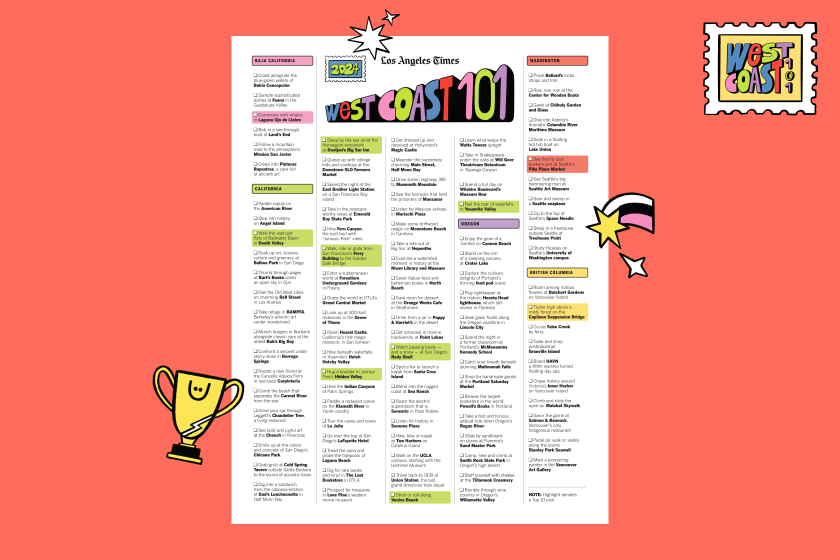Luxembourg, crossroad of cultures
When I set out to visit the smallest countries in Europe, I put Luxembourg at the top of the list.
Then I opened my atlas and found that Luxembourg is in sixth, behind Andorra, on a list of Continental Europe’s dinkiest nations. It is almost as big as Rhode Island, with an area of 998 square miles and nearly half a million people.
You can drive across the grand duchy in 30 minutes. It looks so much like neighboring Germany, France and Belgium that you’d miss it if you didn’t know it was there.
But I was watching for Luxembourg when I crossed into it this summer, intending to get to know another little, lost European country right out of the Brothers Grimm. Apparently I was in denial that it joined modern Europe long ago.
I got caught in traffic near Luxembourg City, home to the government of the grand duchy, museums, historic sites, international corporations, branches of the European Union and 180 banks. I tried to circumvent the capital on back roads but finally admitted I was lost.
It’s a good thing to get lost on winding country roads north of the capital. Most of them lead into the deep, dark forest of the Ardennes. Stippled by mountains and deeply creased by the Sure, Alzette and Woltz rivers, the region was deemed impenetrable by medieval armies and desperately contested in World War II’s Battle of the Bulge. Now the Ardennes is a fine place for walking, biking and driving.
Eventually I arrived in Gaichel about 50 yards from the Belgian border. The village has an inn, gas station and nine-hole golf course that straddles an international border, meaning golfers can drive in one country and putt in another.
The venerable old inn, which occupies two buildings on a crossroads, was founded in 1853 and thereafter maintained by six generations of women (with help from their husbands).
Soon after I checked in I met Celine Guillou, whose grandfather Rene Jacquemin, a Dijon, France-trained chef, won the kitchen’s first Michelin star in 1968. Her grandmother Marie Therese lived at La Gaichel as a little girl during World War II when the Germans occupied it.
Since then, the inn has grown and prospered. Besides the elegant 12-room Hotel-Restaurant La Gaichel, it includes the more modest but thoroughly charming, 17-room Auberge de la Gaichel, with its own bistro. I dined on the terrace, choosing a Pinot Blanc from eastern Luxembourg to accompany an entree of chicken in a nest of spring vegetables.
The next morning I rode a bicycle from the inn to the pretty town of Eischen just over the hill, then found a one-lane road bordered by pastures leading to the ruins of the 13th century Cistercian Abbey of Clairefontaine. The abbey’s still-standing neo-Romanesque chapel has a potent reminder of the Middle Ages in the tomb of Countess Ermesinde, who ruled the region from 1226 to 1247.
By a stroke of luck it was Whit Tuesday, the day of the Dancing Pilgrims Procession in the town of Echternach in eastern Luxembourg.
No one knows precisely when or why the festival began, though it centers on the town’s magisterial Benedictine Abbey and Basilica of St. Willibrord, a monk who arrived in 698 to lay the groundwork for one of the most accomplished schools of manuscript illumination in the early Middle Ages.
The strange Whit Tuesday dance supposedly imitates the symptoms of diseases such as epilepsy that the pilgrims sought to mitigate through St. Willibrord’s intercession.
Echternach was reduced to rubble in the war but rebuilt so that its Gothic marketplace, town hall and basilica make an outstanding backdrop for the dancing procession.
When I arrived, the town was jammed with tourists, mostly speaking German (French and Luxembourgian are also official languages), lined up along the winding main street. I found a place at a sidewalk cafe and was ordering an espresso when I heard the boom of an oompah band and caught sight of clergymen at the head of the procession.
Ranks of dancers -- all male -- followed under banners identifying their parishes. One group of pilgrims stopped in front of my table and began to hop from one foot to the other, followed by another group and then another, all performing their strange quadrille with dignity and deliberation.
When the last ranks finally reached the square in front of the church, they filed in for Mass and I had lunch, imagining the dancing pilgrims on their way to work at a bank in Luxembourg City the next morning.
That afternoon I drove through the countryside of northern Luxembourg, keeping a loose grip on my map because I no longer thought it productive to try to avoid getting lost. Pristine villages and handsome houses with manicured lawns suggest money, and statistics bear it out. Luxembourg has the highest per capita gross domestic product in the world.
But another beautifully manicured lawn at the Luxembourg American Cemetery east of the capital, in the town of Hamm, tells a different story about a war-ravaged country and the American fighting men who liberated it from German occupation during World War II. More than 5,000 U.S. soldiers lie beneath simple white crosses, most of whom died in the brutal Battle of the Bulge.
It was Hitler’s last gasp, beginning Dec. 16, 1944, six months after D-day, with a massive, surprise German offensive into eastern Belgium and Luxembourg. Many green American troops were stationed there along a seemingly quiet front, which had a southern terminus at Echternach.
As German soldiers poured into the Ardennes, the Allied Command called up the 3rd Army. It was headed by Maj. Gen. George Patton, who made his place in military history during the Battle of the Bulge. He died in a car crash just after the war and was buried at the Luxembourg American Cemetery.
Unlike other mini-states in Europe tucked into out-of-the-way mountain places, Luxembourg is in the middle of things, making it ever a passageway and prize for foreign armies.
Its capital city, Luxembourg, on a plateau deeply cut by the Alzette and Petrusse rivers, was a natural bastion even before a long line of conquerors added three rings of walls, 24 forts and 14 miles of tunnels.
This stout ensemble of fortifications, along with the old town it protected, is a UNESCO World Heritage Site and Luxembourg City’s chief attraction. It is accessible along steep walkways leading to a district below the promontory known as the Grund.
The next day, in town, I inspected the fortifications, sat with a coffee in the leafy Place d’Armes, watched a solitary, uniformed guard pace in front of the Grand Ducal Palace, the official home of Luxembourg’s head of state and constitutional monarch, Grand Duke Henri, and toured the excellent Luxembourg City History Museum where I learned about Luxembourgian sports stars. Johny Grun was a weightlifter who, in his prime about 1900, could lift two horses and their riders on a platform above his head; and cyclist Charly Gaul, called the “Angel of the Mountains,” who won the 1958 Tour de France.
Then I crossed the Alzette River valley to the enclave of conference centers and corporate offices atop the Kirchberg-Plateau, also home to Luxembourg’s I.M. Pei-designed Museum of Modern Art. The beautiful building, all space and light, showcases some selections from its own collection but is chiefly devoted to top-flight temporary exhibitions.
The museum’s cafe, a whimsically decorated work of art itself with refectory tables under a pergola, was a good stop for a salad at lunch, followed by a stroll across the nearby remains of a set of French-built fortifications.
On my way back to La Gaichel, I got lost again, which is how I found a partly restored 11th century castle in the village of Useldange. I climbed into its keep to get a closer look at its two towers, then sat contentedly by the nearby Attert River.
The grand duchy may be thoroughly integrated into modern Europe. But, I thought, you don’t have to scratch the surface too deeply to find Countess Ermesinde, St. Willibrord and the Middle Ages.
--
Sign up for The Wild
We’ll help you find the best places to hike, bike and run, as well as the perfect silent spots for meditation and yoga.
You may occasionally receive promotional content from the Los Angeles Times.



